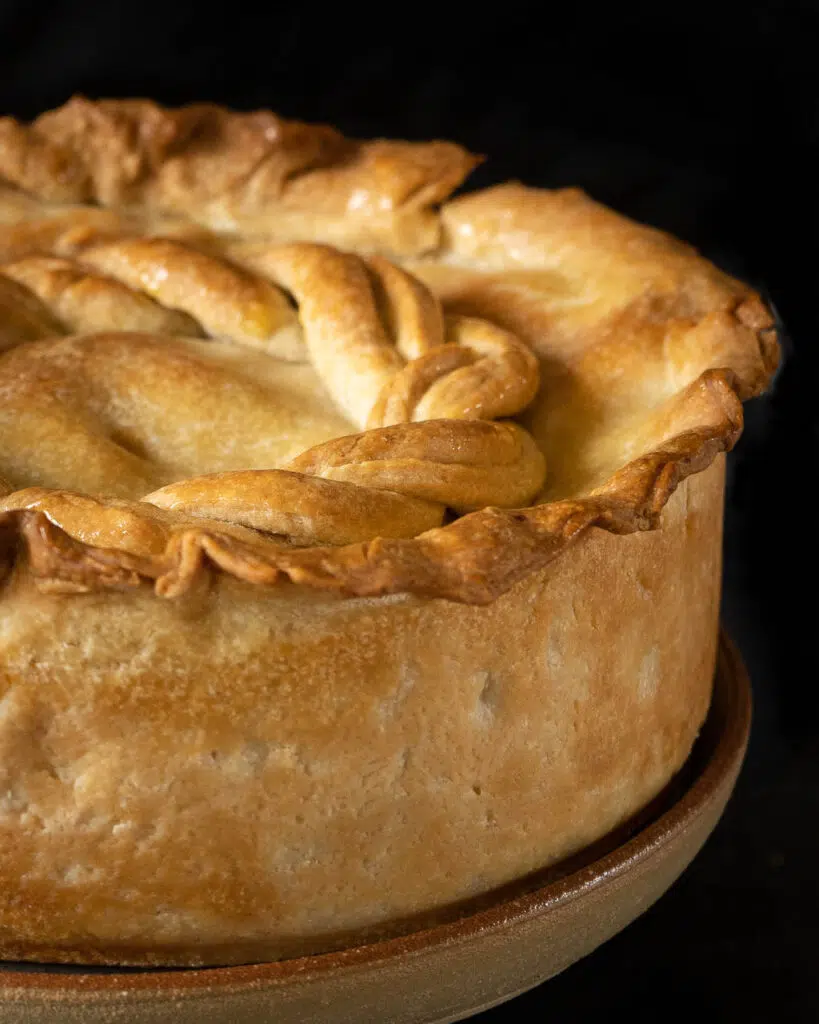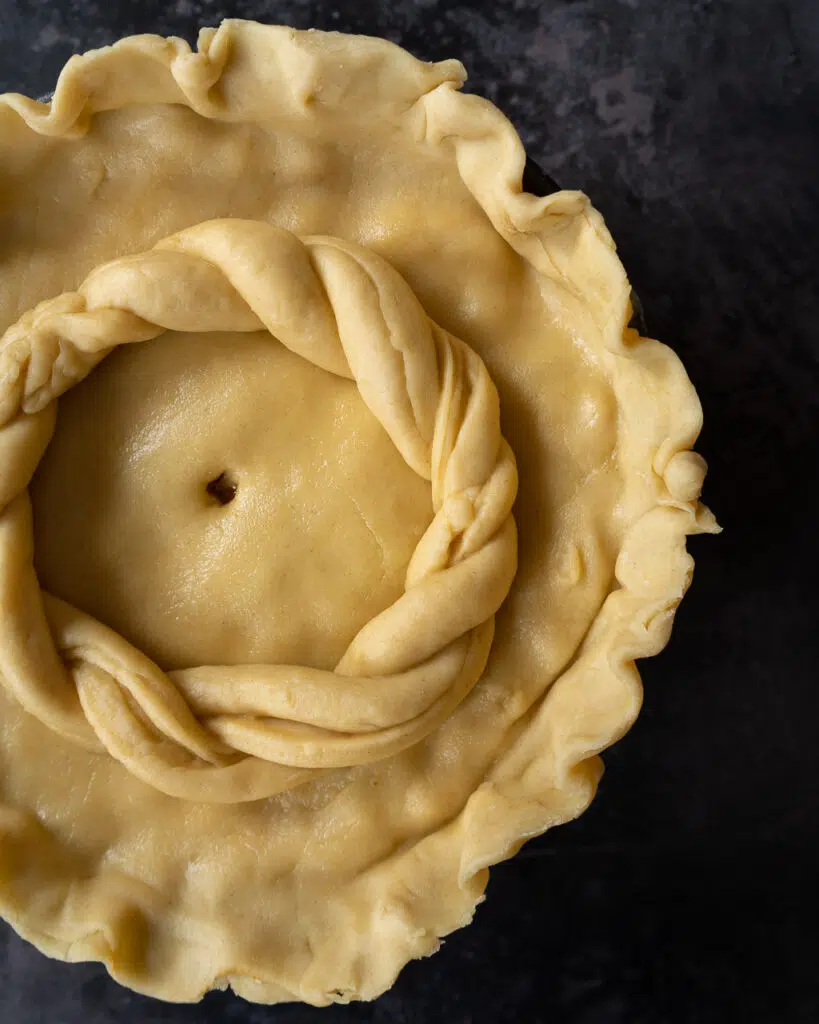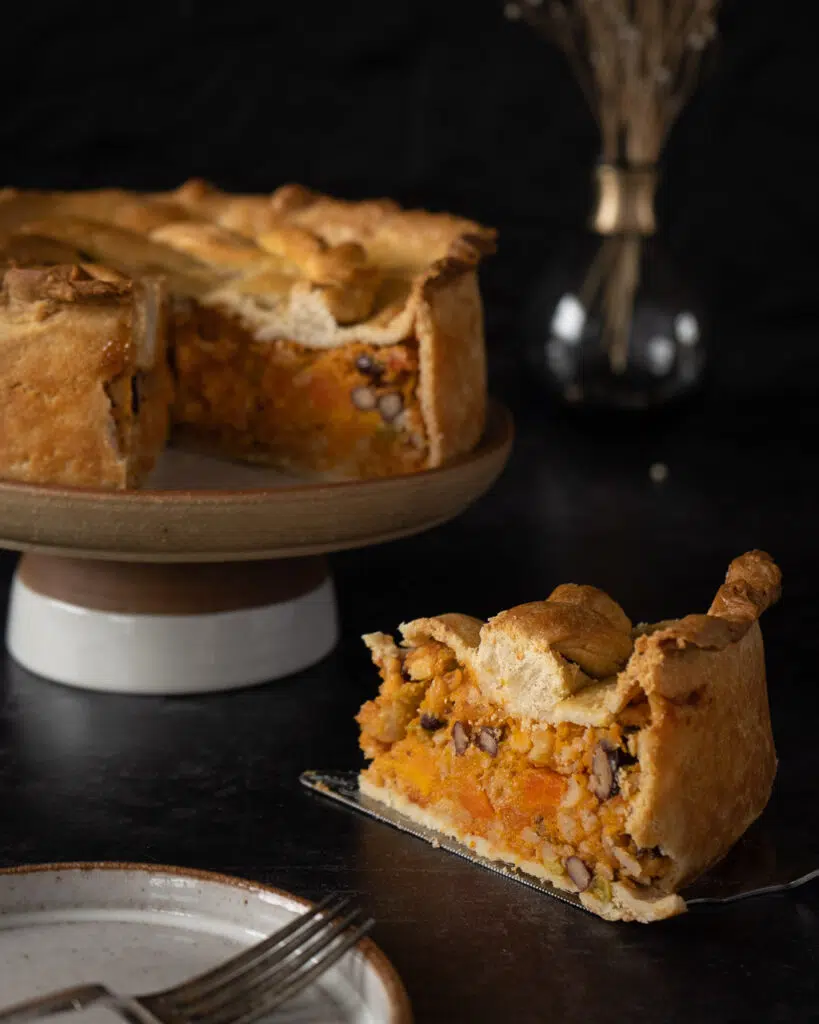When you buy through our links, we may earn a commission. Learn more.
Hot water crust pastry is incredibly easy to veganise and it makes the most delicious savoury pie crust. I don’t know why it is not used more often! This vegan hot water crust pastry is beautifully crisp, flavoursome and holds its shape – making it perfect for deep-filled pies, both small and large.
There will not be a ‘soggy bottom’ in sight with this pastry, it bakes to perfection and is very therapeutic to make. Instead of needing to keep it cold like normal pastry the opposite is true for this hot water crust pastry – you make it and shape it whilst it is warm and pliable.
It’s made with vegetable shortening which gives it the most beautifully crisp texture but if you’re in a bind you can substitute with coconut oil – in fact the pie pictured here was made using coconut oil, although I recommend vegetable shortening for the optimal hot water crust texture.
This beautiful vegan pastry can be used for a wide variety of pies – why not try filling it with your favourite curry? I did just that and adapted my Vegan Katsu Curry Sauce recipe into a Curried Chickpea & Potato Pie using this pastry, which was absolutely delicious. The recipe is coming soon to the blog!
This vegan hot water crust pastry is:
Quick and easy to make
Beautifully crisp
Deliciously seasoned
So versatile
Dairy free, egg free and vegan
I have no doubt that you will LOVE this recipe – be sure to tag me on Instagram when you make it @aveganvisit 🙂
The Video Recipe:
The Written Recipe:

How To Make Vegan Hot Water Crust Pastry
Ingredients
- 420 g plain flour
- 80 g strong white bread flour
- 100 g dairy free margarine
- 200 ml water
- 120 g vegetable shortening (*see notes)
- 2 tsp salt
Instructions
Make the pastry:
- In a large bowl rub together the two flours and dairy free margarine until the mixture is the consistency of fine breadcrumbs.
- In a saucepan over a low heat, add the water, shortening and salt. Heat gently until the shortening has melted but don’t let the mixture boil.200 ml water, 120 g vegetable shortening, 2 tsp salt
- Once the shortening has melted into the water, bring the mixture to the boil. Once the liquid is in a rolling boil (about 1 minute), take it off the heat and pour it over the flour mixture straight away.
- Mix the flour and liquid together with a spoon and once it is cool enough to handle, knead it gently for two minutes to bring the mixture together fully.
- Lightly flour a surface and roll the dough out to 1/4-1/2 cm (1/4 - 1/8") thick. You want to work relatively quickly because the dough is much easier to roll out and handle when it is still warm.
- Select a baking tin - ideally a non-stick springform cake tin (20cm / 8") for a large pie or a large muffin tin with removable bases for small pies. As long as you are using a good non-stick tin with a removable base you should not need to line the tin with parchment paper.
- Cut out the pastry to fit your baking tin and gently shape it to the tin, leaving a 1-2 cm (1/2-1") overhang around the edge to join the lid to later on. Hot water crust pastry is very forgiving so you can patch, press and stretch it as necessary to fit your tin.
- Cut out a lid with a small steam hole in the middle and place it on a tray. Put the lid in the fridge along with your pie case for 30 minutes to chill and firm up.
Bake the pie:
- Once your pastry has chilled, fill it with a cold filling and attach the lid by pinching it together with the overhang from the pie crust. You may need to leave the pastry out of the fridge for 5 minutes before it’s pliable enough to pinch together.
- If you’re not quite ready to bake your pie then put it back in the fridge whilst you preheat the oven to 190°C fan (210°C conventional / 400°F / gas mark 6).
- Bake your pies - for a large pie you’re looking at around 50-60 minutes and for smaller muffin-sized pies 30-40 minutes until the pies pies are golden all over and around the sides (carefully pop it out of the tin slightly to check).








